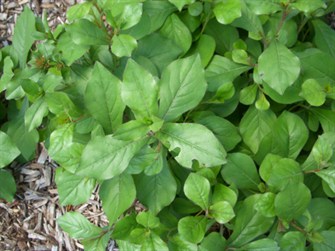In this issue:
Testing the mettle of a dormant lawn
Hue new about lily color changes?!
Sneaky daylilies don't play nice
Oakleaf hydrangea: Not your fault!
Taking up arms against weevil
Amazing news in plant-pest wars
This page is Sponsored by:

Above: In high summer its tough to say which is prettier,
Crocosmia or rain drops. Want this gorgeous combination of hot
color and cool water as a refreshing decoration for your
wall?
Lily color changes

Above: True lilies (Lilium species and hybrids) are
mid-summer delights. However, they are not always aesthetically
pleasing after blooming. We deadhead them as the blooms fade and
then, several weeks later we cut back the established plants --
those with multiple stems -- if they are cluttering a scene. We
have no qualms about cutting them down to the ground long before
they would have faded on their own. They come back.
Below: A Lilium bulb increases in size; here, a year of
moderate growth. If a lily is a genetically unstable variety, it
can be making big changes here that you won't notice until some
time in the future. As new "daughter bulbs" grow, each develops its
own stem and eventually blooms -- which is when you might first
notice significant mother-daughter differences. Especially vigorous
daughters or those with genes for greater height or bigger leaves
than their mother may reach blooming size pretty quickly and even
crowd the mother plant so that the original bulb dwindles over
time. Notice that the daughter bulbs form at the outside edge of
the motherb bulb. Their roots able to enter soil as yet unclaimed
by the mother's roots. We think of this as an offset's positional
advantage, giving it the chance to exploit new sources of water and
nutrient.

Roadside daylilies untrustworthy among their own kind
Below: Hybrid daylilies increase by mannerly, short offset.
The blue line shows this hybrid's average extension.

Below: The wild "ditch lily at the far left edge of this
photo sent a runner 24" to the right, where it came up snug against
the crown of a neighboring, hybrid daylily. Janet's loosened the
soil with a fork and lifted out the running root (orange line
parallels the runner root she's exposed). The leaves of this
aggressive running daylily are wider and usually paler in color
than the hybrids around it, but that distinction is all too easy to
overlook as the wild thing takes over.

Black vine weevil fodder

Above: Black vine weevil and the notch it ate from a coral
bell (Heuchera) leaf in one night.
Below: Learn to recognize the notching. It's on plumbago
(left) and Lenten rose (right, below).


Thank goodness for small favors. In the case of black vine
weevil, that the adult's damage is distinctive and the insects do
not move far in their feeding and egg-laying. Look for notches as
shown above, checking new foliage low on the plant to begin with
since these insects are shy, slow and night-feeding. Where you see
the damage, take action. Don't treat undamaged plants because the
products that work on black vine weevil are potent, long lasting
and very likely to cause serious collateral damage in local
beneficial insect populations -- which can lead to more trouble.
Best to limit that fall-out!

Sponsored by: Susan Budrys

For more Sponsor-recommended
articles...
Sponsor Us and tell us the topic you
are interested in.
We have posted a great deal of our library
already but have much still to post.
It helps to have Sponsors directing the sequence.
